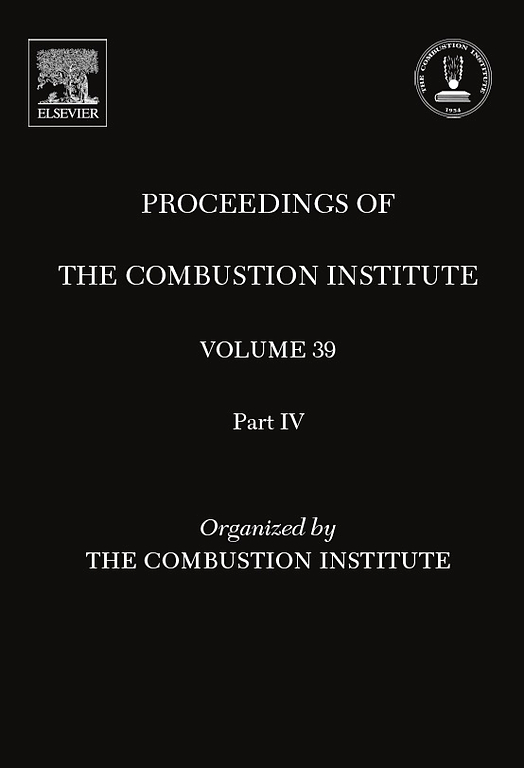Soot formation as a function of flow, flame and mixing field above evaporating fuel films in an optically accessible engine
IF 5.3
2区 工程技术
Q2 ENERGY & FUELS
引用次数: 0
Abstract
Liquid fuel wall films are a known source of hydrocarbon and soot emissions in direct-injection spark-ignition (DISI) engines. Therefore, a comprehensive understanding of the evaporation, mixing, and combustion processes above wall films is desirable. In this study, laser-induced fluorescence (LIF) of acetone excited at 315nm is used to measure the fuel mole fraction in the gas phase above a wall film in an optically accessible DISI engine. To this end, acetone and 3-pentanone are characterized at excitation wavelengths from 305 to 316nm in a heated jet experiment under atmospheric conditions. It is shown that the excitation of acetone at 315nm results in a signal that is sufficiently temperature-independent under engine-relevant conditions. In addition, simultaneous high-speed particle image velocimetry (PIV) and Mie-scattering capture the flow field and cross-sectional flame development. The formation of soot is characterized by natural luminosity. A late injection of acetone during the compression stroke from a single-hole Spray M injector is used to add approximately 8% of the fuel to the homogeneously premixed isooctane-air mixture and form a fuel film on the piston surface. Heavy soot formation occurs when the engine is operated under cold start conditions. After combustion, incandescent soot structures form and persist until the exhaust phase. These soot structures are attributed to the pyrolysis of the fuel as it evaporates into the oxygen-depleted, high-temperature burnt gas. Increasing wall temperatures during cold-start cycles significantly reduces soot formation. However, even at similar temperature levels, strong variations occur. A multi-parameter analysis revealed a strong correlation of the projected soot area with the flow field at ignition and the acetone mole fraction above the film. It is shown that delayed flame-film contact reduces soot formation since it increases the time for evaporation and promotes mixing of acetone-rich regions. Acetone mole fractions in the bulk flow indicate strong turbulent mixing, with fuel-rich regions contributing to soot formation during combustion being typically limited to within 3 mm of the wall.烟尘形成与光学可及发动机中蒸发燃料薄膜上方的流量、火焰和混合场的函数关系
液体燃料壁膜是直喷式火花点火(DISI)发动机中碳氢化合物和烟尘排放的已知来源。因此,需要全面了解壁膜上方的蒸发、混合和燃烧过程。在本研究中,利用波长为 315nm 的丙酮激光诱导荧光 (LIF) 来测量光学可及 DISI 发动机壁膜上方气相中的燃料分子分数。为此,在大气条件下进行的加热喷射实验中,丙酮和 3-pentanone 的激发波长为 305 至 316 纳米。结果表明,在发动机相关条件下,315 纳米波长的丙酮激发产生的信号与温度无关。此外,同步高速粒子图像测速仪(PIV)和米氏散射捕捉到了流场和火焰横截面的发展。烟尘的形成以自然发光为特征。在压缩冲程期间,通过单孔喷雾式 M 喷射器喷射丙酮,在均匀预混的异辛烷-空气混合物中加入约 8%的燃料,并在活塞表面形成一层燃料膜。发动机在冷启动条件下运行时会形成大量烟尘。燃烧后,形成炽热的烟尘结构,并一直持续到排气阶段。这些烟尘结构是由于燃料在蒸发到缺氧的高温燃烧气体中时发生热解而形成的。在冷启动循环期间提高壁温可显著减少烟尘的形成。然而,即使在相似的温度水平下,也会出现很大的差异。多参数分析表明,投影烟尘面积与点火时的流场和薄膜上方的丙酮摩尔分数密切相关。结果表明,延迟火焰与薄膜的接触可减少烟尘的形成,因为它增加了蒸发时间,并促进了富含丙酮区域的混合。散装流中的丙酮分子分数显示出强烈的湍流混合,在燃烧过程中导致烟尘形成的富燃料区域通常限制在距离壁面 3 毫米的范围内。
本文章由计算机程序翻译,如有差异,请以英文原文为准。
求助全文
约1分钟内获得全文
求助全文
来源期刊

Proceedings of the Combustion Institute
工程技术-工程:化工
CiteScore
7.00
自引率
0.00%
发文量
420
审稿时长
3.0 months
期刊介绍:
The Proceedings of the Combustion Institute contains forefront contributions in fundamentals and applications of combustion science. For more than 50 years, the Combustion Institute has served as the peak international society for dissemination of scientific and technical research in the combustion field. In addition to author submissions, the Proceedings of the Combustion Institute includes the Institute''s prestigious invited strategic and topical reviews that represent indispensable resources for emergent research in the field. All papers are subjected to rigorous peer review.
Research papers and invited topical reviews; Reaction Kinetics; Soot, PAH, and other large molecules; Diagnostics; Laminar Flames; Turbulent Flames; Heterogeneous Combustion; Spray and Droplet Combustion; Detonations, Explosions & Supersonic Combustion; Fire Research; Stationary Combustion Systems; IC Engine and Gas Turbine Combustion; New Technology Concepts
The electronic version of Proceedings of the Combustion Institute contains supplemental material such as reaction mechanisms, illustrating movies, and other data.
 求助内容:
求助内容: 应助结果提醒方式:
应助结果提醒方式:


